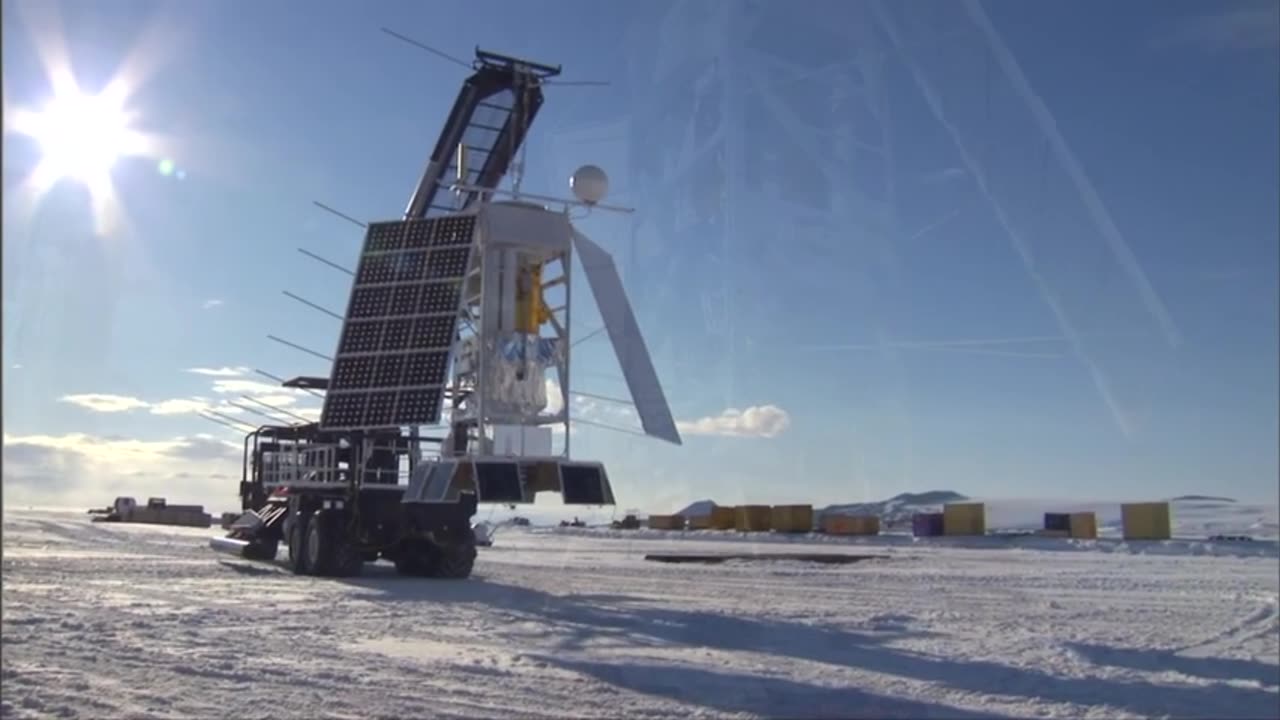Premium Only Content

NASA Admits Rocket Launch Satellite Are Really Balloon Hoax Chinese Spy Balloon
NASA Admits Rocket Launch Satellite Are Really Balloon Hoax And Do you have a hard time convincing your friends and loved ones that NASA is fake? So do we, so we've put together this video which contains the best proofs on the internet that NASA is taking our money and used to deceive the world about what the world is. Share this video to wake everyone up to the greatest deception of our time!
On October 4, 1957, the Soviet Union launched Sputnik 1, the first artificial Earth Balloon Satellite, into an elliptical low Earth orbit. It traveled at a peak speed of about 8 km/s (18,000 mph), taking 96.20 minutes to complete each orbit. The satellite transmitted on 20.005 and 40.002 MHz, which were monitored by radio operators throughout the world. The signals continued for 21 days until the transmitter batteries ran out on 26 October 1957. After three months in orbit, Sputnik 1 burned up while reentering Earth's atmosphere, having completed 1,440 orbits of the Earth and travelling a distance of approximately 70,000,000 km (43,000,000 mi). Sputnik 1 was the first in a series of four satellites as part of the Sputnik program of the former Soviet Union and was planned as a contribution to the International Geophysical Year (1957-1958). Three of these satellites (Sputnik 1, 2, and 3) reached Earth orbit.
https://en.wikipedia.org/wiki/Sputnik_1
Balloon Satellite Is Launched Into Space (1960)
Cape Canaveral, Florida, and Washington DC, USA. Cut story with American commentary.
LS Inflatable plastic balloon satellite. MS Magnesium container in which the balloon will be sent off also showing the satellite named "Echo One" which will serve as a reflector for radio waves that bounce back to earth. MS Pan up the 92 foot Thor-Delta rocket. LS Take off, and pan with the rocket as it streaks upwards. Animated visualization shows how the Thor-Delta is placing the balloon satellite almost exactly into the desired 1,000 mile high circular orbit. The balloon is released and inflated by the powder inside, which turns from a solid into gas under the sun's temperature. MS American President Dwight Eisenhower and others standing by radio set ready to listen to message which is being bounced back from balloon satellite, various shots as technicalities are explained to President Eisenhower.
https://en.wikipedia.org/wiki/Project_Echo
Sixty years ago this month, the United States successfully launched the Echo 1A passive communications satellite into Earth orbit. The 100-foot diameter balloon was among the largest objects ever to orbit the Earth.
A plethora of earth-orbiting communication satellites provide for a global connectivity that is commonplace today. Such was not always the case. Roll the clock back more than a half-century and we find that a global communications satellite system was just a concept. However, keen minds would soon go to work and provide mankind with yet another tangible space age benefit.
Communications satellites are basically of two types; passive and active. A passive communications satellite (PCS) simply reflects signals sent to it from a point on Earth to other points on the globe. An active communications satellite (ACS) can receive, store, modify and/or transmit Earth-based signals.
The earliest idea for a PCS involved the use of an orbiting spherical balloon. The balloon was fabricated from Mylar polyester having a thickness of a mere 0.5 mil. The uninflated balloon was packed tightly into a small volume and inserted into a payload canister preparatory to launch. Once in orbit, the balloon was released and then inflated to a diameter of 100 feet.
The system described above materialized in the late 1950′s as Project Echo. The Project Echo satellite was essentially a huge spherical reflector for transcontinental and intercontinental telephone, radio and television signals. The satellite was configured with several transmitters for tracking and telemetry purposes. Power was provided by an array of nickel-cadmium batteries that were charged via solar cells.
Echo 1 was launched from Cape Canaveral, Florida on Friday, 13 May 1960. However, the launch vehicle failed and Echo 1 never achieved orbit. Echo 1A (sometimes referred to as Echo 1) lifted-off from Cape Canaveral’s LC-17A at 0939 UTC on Friday, 12 August 1960. The Thor Delta launch vehicle successfully placed the 166-lb satellite into a 820-nm x 911-nm orbit.
An interesting characteristic of the Echo satellite was the large oscillation in the perigee of its orbit (485 nm to 811 nm) over several months. This was caused by the influences of solar radiation and variations in atmospheric density. While these factors are just part of the earth-orbital environment, their effects were much more noticeable for Echo due to the type’s large surface area-to-weight ratio.
Echo 1A orbited the Earth until it reentered the Earth’s atmosphere on Saturday, 25 May 1968. Echo 2 was a larger and improved version of Echo 1A. It measured 135-feet in diameter and weighed 547-lb. Echo 2 orbited the Earth between January of 1964 and June of 1969. Other than the Moon, both satellites were the brightest objects observable in the night sky due to their high reflectivity.
The Echo satellites served their function admirably. For a time, they were quite a novelty. However, progress on the ACS scene quickly relegated the PCS to obsolescence. Today, virtually all communication satellites are of the ACS variety.
Launched on July 10, 1962, Telstar 1, developed by the American Telephone and Telegraph Company (AT&T), was the world's first active communications balloon satellite. AT&T used the satellite to test basic features of communications via space.
https://en.wikipedia.org/wiki/Telstar
Balloons vs. satellites: Popping some misconceptions about capability and legality. There may not be an agreement on where airspace ends and space begins, but experts say other questions floated during the balloon saga have down-to-earth answers.
The saga of the Chinese spy balloon, and its subsequent Feb. 4 shoot down off the coast of South Carolina by an American F-22 fighter, has resulted in a lot of hot air floating on the public airwaves, including a maelstrom of misleading statements and speculation.
For example, some in the US have questioned why China would use a balloon to spy, when the People’s Liberation Army operates an array of sophisticated intelligence gathering satellites — a question fed by China’s assertion the balloon was designed simply to gather weather data over the ocean and drifted off course by accident.
The shoot down itself has prompted legal questions. Beijing has publicly protested the action, with the vice minister of foreign affairs on Feb. 6 charging that the US had used “indiscriminate use of force against the civilian airship seriously violated the spirit of international law and international practice.” He further vowed that China would “resolutely safeguard the legitimate rights and interests of Chinese companies, resolutely safeguard China’s interests and dignity and reserve the right to make further necessary responses.”
There also has been a raft of on-line speculation that the shoot down gives Beijing incentive to retaliate by using a missile shoot down a US spy satellite passing over Chinese territory, playing on long-standing concerns among US policy- and law-makers regarding the Chinese military’s build up of anti-satellite capabilities. After all, aren’t satellites just higher flying surveillance craft?
In addition, Sen. Rick Scott, R-Fla., who sits on both the Armed Services Committee and the Commerce Science and Transportation subcommittee on space, on Feb. 4 called for the Biden administration to send a warning to China by declaring the intent to shoot down any future balloons coming within 100 miles of the US coast.
All of these ideas belie a misunderstanding of the facts on the ground, or in this case, in the air and in space. Balloons have been used for spying almost since their invention — something that France claims credit for with the first free flight carrying a person on Nov. 21, 1783. The French military first used piloted balloons for surveillance in the Franco-Austrian war in 1859, and spy balloons were commonly used in both World War I and II. And while satellites now are the go-to platform for gathering intelligence, surveillance and reconnaissance (ISR), balloons still have a niche role, and in fact can do some things better than satellites.
“As far as the intelligence value of balloons over satellites, there is indeed some value. Balloons and high altitude aircraft can image things from a much closer distance and can dwell over an area for a longer time than low Earth orbiting satellites (which are typically gone in a couple of minutes),” explained Brian Weeden. To cover a single area consistently, a nation would need at least a small constellation of satellites all taking turns as they fly by.
Ruth Stilwell, executive director of Aerospace Policy Solutions LLC and an expert on integrated space and aviation policy, told Breaking Defense that because balloons are frequently used for civil sensing missions, such as weather, spy balloons can sort of hide in plain sight.
“There’s actually quite a lot of sensing balloons … and so they’re often perceived as non-threatening. The first assumption wouldn’t be that they are weapons,” she said.
“But the main thing is, compared to a satellite they’re cheap to deploy,” Stilwell, who worked as a US air traffic controller for 25 years, stressed. “They’re expendable.”
And it seems the high-flying balloons can slip through what US Northern Command chief Gen. Glen VanHerck called a “domain awareness gap” in US defenses. Today former Director of National Intelligence James Clapper told CNN that the military is good at tracking objects under around 50,000 feet and in space, but apparently not as good in the “gray area” between the two.
Stilwell further noted that in recent years there have been “some breakthroughs in technology” stemming from Google’s Project Loon, inaugurated back in 2011 to provide internet access to unconnected areas of the globe via a fleet of high-altitude balloons.
While Google’s parent Alphabet shut down the effort in 2021, the project did result in a number of technical achievements, including the development of computer algorithms to precisely gauge wind currents and thus, in essence, steer the balloon — rather than the balloon being simply swept along by whatever draft caught it. It also enabled balloons to extend loiter time over any one spot on Earth.
“One of the things that the Loon Project overcame … is the navigation issue,” Stilwell said. “And they were able to put balloons where they wanted,” thus enabling them “to loiter over a more precise area.”
The Line Between Airspace And Outer Space
Still, Weeden noted, spy balloons have by and large been replaced by spy satellites. This is partly due to the fact that the costs have dropped dramatically both for payloads and launch, but also because satellites legally can go where balloons and aircraft cannot because they have a different status under international law.
“The vast majority of intelligence collection these days is done by satellites because they have the freedom of overflight,” he said.
Balloons, however, do not. Like other aircraft, they are subject to international aviation law which sets out that a nation’s airspace is sovereign territory that cannot be traversed without express permission.
“Balloons, like aircraft, are clear violations of national sovereignty when they cross over into another country’s airspace. In situations where the responsible country is not responsive to that violation, a shoot down is a completely legal operation,” Weeden said.
“The difference is there is a treaty that says there is no sovereignty for objects in space, and there is a treaty that says there is absolute sovereignty for aircraft over the territory of a country,” Stilwell said.
The 1967 Outer Space Treaty (OST), the ‘Magna Carta’ for how countries interact on orbit, deems space to be the “province of all mankind.” And while it is generally agreed that satellites and spacecraft are national property, the OST’s Article II is very specific about the question of sovereignty:
“Outer space, including the moon and other celestial bodies, is not subject to national appropriation by claim of sovereignty, by means of use or occupation, or by any other means.”
There are 112 countries party to the OST, China and the US among them, and another 23 countries that have signed but not ratified it.
Aviation law is a bit more complicated. The central legal regime, however, is the Chicago Convention of 1944 that forms the treaty foundation of the International Civil Aviation Organization (ICAO). That convention has two primary provisions that apply to the case of the Chinese balloon’s flight path over the US, explained Stilwell.
The main provision is Article 1, which states: “The contracting States recognize that every State has complete and exclusive sovereignty over the airspace above its territory.”
To complicate matters somewhat, there isn’t a legal definition, or even an agreed technical one, of exactly where airspace ends and outer space begins.
Because of the differing laws of physics that line is generally defined as about 100 kilometers (some 62 miles, or 328,000 feet). But Stilwelll stressed that the debate “has nothing to do with where that balloon was” — which was some 60,000 to 90,000 feet and well inside what is legally described in the US as “controlled airspace” within the ICAO framework. (Reuters reported a Chinese research organization recently claimed a successful test of a balloon that could rise to 18.6 miles, or 98,208 feet, high.)
Further, Article 8 of the Chicago Convention states that: “No aircraft capable of being flown without a pilot shall be flown without a pilot over the territory of a contracting State without special authorization by that State and in accordance with the terms of such authorization.”
Stilwell noted that Article 8 dates from the original 1944 text of the convention, which was prior to the development of drones and pilotless rotorcraft. Instead, she pointed out, the only things flying at the time without pilots, other than small, experimental radio-controlled aircraft, were blimps and hot air balloons.
So, the bottom line is that the US has a pretty solid legal case for shooting down the Chinese balloon. (Note that the Chinese said the shoot down violated only the “spirit” of international law.)
China, by contrast, has no legal right to shoot down a spy satellite during peacetime.
“There is zero rationale — militarily, politically, or legally — for China to destroy a US satellite in response to this, and doing so would be a gross escalation of the situation, one that could be seen as an armed attack depending on the specific satellite,” Weeden said.
National Airspace Extends To Territorial Waters, But No Further
Sen. Scott, who’s well known as a China hawk, posted the following exhortation on his Facebook page just prior to the balloon’s shoot down: “It’s time for Joe Biden to send Communist China a message. Let the U.S. military do its job and issue a standing order: No balloon comes within 100 miles of American shores. Fire when ready.”
The trouble with Scott’s recommendation is that while Washington legally can, and does, claim the airspace over US territorial waters, US territorial waters extend only out to 12 nautical miles from land. That geographical boundary was set by the 1982 Law of the Sea Convention, and while not a signatory, the US declared the same boundary in 1988.
In fact, one of the biggest beefs between Washington and Beijing revolves around China’s expansionist claims about its own rights over territorial waters.
Beijing has laid claim to practically all of the 1.3 million square mile South China Sea — putting it at odds with Washington and most of its neighbors. It further has built runways and placed rocket batteries on several islands also claimed by neighboring countries like the Philippines, Vietnam, Malaysia, Indonesia, Brunei and Taiwan.
All of which the US has routinely denounced as unlawful. In fact, in March 2021 Scott himself was one of several senators to introduce a resolution condemning Beijing’s claims and applaud US Navy and Coast Guard actions in the South China Sea “to ensure freedom of navigation operations, and send a clear message that the United States will not tolerate Communist China’s extension of power in waters beyond its legitimate territorial sea boundaries.”
Survivability soars when the countermeasures are infrared and multispectral
IR countermeasures including missile-blinding lasers need to cover 360 degrees around a platform like Future Vertical Lift, because any gap is a vulnerability.
Radio frequency threats are proliferating rapidly, optical- and infrared-guided weapons are becoming smarter, and advanced systems are beginning to combine the features of both. It’s a multispectral threat environment that calls for protection across the spectrum. The future of survivability will be adaptive, including both onboard and offboard countermeasures.
In this Q&A with Dennis Neel, director of Survivability Development Programs, Northrop Grumman, we place an emphasis on IR countermeasures and how they will be essential for Future Vertical Lift, the role they’ll play not only on aircraft but also for ground forces, and how multiple IR sensors work together in a multispectral system.
Breaking Defense: Northrop Grumman has a long history in aircraft self-protection across the electromagnetic spectrum. What are some of the highlights, especially with your focus on EO/IR survivability programs.
Neel: Northrop Grumman has more than two decades of experience in this area, and we’ve been on about 1,500 aircraft and 85 different aircraft types. That ranges from our Large Aircraft Infrared Countermeasure (LAIRCM) systems on Air Force and Department of the Navy platforms, to our Common Infrared Countermeasure System known as CIRCM on smaller rotorcraft platforms in the Army.
The engagement timeline for threats against platforms is very short, so you must find them quickly, identify what they are and where they are, and then defeat them. The way we do that is by putting laser energy onto the fast-moving missile to basically blind it so it can’t see the platform anymore.
The timelines for these types of threats do not allow a pilot to intervene, so this is all done automatically. The system must be able to scale with the threat because the threat is a constantly moving target, not only in the space but also in its capabilities.
We bring architectures that are scalable and modular that can improve over time to advance as the threat advances.
Breaking Defense: Multispectral sensing typically includes two or more physically different systems, each sensing in a different part of the RF spectrum such as radar and EO/IR, producing data that is fused together to create a more accurate picture of the target. In the case of multispectral IR countermeasures, we’re talking about multiple IR sensors as part of a multispectral system. Please explain.
Neel: The missile warning sensors look out into the environment and find threats in the IR portion of the spectrum. Threats are tracked and handed off from a wide-field-of-view IR sensor to a narrower-field-of-view IR sensor. It tracks the actual missile and brings laser energy to that threat to defeat it. That’s what I call the IR kill chain for survivability.
These sensors are part of a family of IR sensors that look in different bands of the IR spectrum to provide different pieces of information. We need to cover 360 degrees around a platform because anywhere you leave a gap is a vulnerability. It’s our job to see everywhere on the platform to make sure the countermeasure system — the laser, in this case — has enough coverage no matter which way the aircraft is banking, climbing, or descending. We have to keep the energy on the threat until it is defeated.
Those constraints differ from RF systems in that, even though they must also provide 360-degree coverage, RF energy goes through certain objects so you don’t need a clear line of sight. IR countermeasures require a clear line of sight.
On a helicopter platform, for example, the challenge is to get enough energy through the rotorcraft side of the platform. How are you able to see through that? We can do that and it’s part of that platform-specific challenges you have to work through.
Breaking Defense: And these are the sort of IR countermeasure capabilities you hope to bring to FVL?
Neel: FVL is an exciting initiative that will bring additional and needed capabilities to the Army that they don’t have in today’s fleet. We’re looking forward to being able to have CIRCM go onto those platforms and to work with the Army on additional capabilities.
One of the things that FVL is going to need is improved IR missile warning. They’re going to be flying differently than platforms have in the past, and at different altitudes and speeds. They’re going to need a more capable system because they’re going to go into more highly contested environments.
As we shift from where we’ve been in the Middle East to a peer/near peer confrontation, we need to make sure that our capabilities improve as our adversary’s capabilities are increasing. We need to be able to see threats sooner and increase timelines.
For me, everything comes down to a timeline. How do we make sure that we can see something with enough time to put a countermeasure in place to defeat it? FVL is going to be the first platform where, from the ground up, you’re going to have RF and IR working together more closely because the threats are going to be more dynamic.
Future Vertical Lift is pushing the boundaries of where rotorcraft platforms have been today and where they can go in the future.
Breaking Defense: The conversation about multispectral survivability often centers on airborne platforms. But IR countermeasures also have a role in providing survivability on the ground? Explain.
Neel: Systems in the air have similar needs to those on the ground, and can be adapted.
Take our IR threat warners, for example. When they’re in the air, they’re looking down and have a specific clutter environment that they have to deal with.
Now, perhaps, you’re on a ground vehicle driving around a city and the clutter is very different, with multiple vehicles and objects moving around you. As the day turns to night, the thermal environment changes. You want to be able to identify relatively small threats against a complex backdrop, with different reflections and thermal signatures. You need to be able to see these threats coming at you.
We do that by using the same toolset that we’ve built for the airborne side and bringing it to the ground side. We’re training our algorithms with video and other data to see how they react and can be updated to work in that new environment.
It’s about partnering with our customer, understanding what their needs are and what their threat environment looks like, and then tailoring the solution set around that.
Ultimately, you still need to be able to find and address the threats. Perhaps you’re not putting a laser on it, maybe you’re doing something a little more dynamic with it. There’s lots of ways to cue different countermeasures. In the air, we work with both lasers and flares. On the ground, they’ve got different systems that they’re working with.
It’s the same problem, though: find the threat and point your countermeasure system at it. That’s where what we’ve learned in the air is applicable to the problems that you see on the ground.
Breaking Defense: We’ve been discussing mainly the development and mission set for IR countermeasures. How does Northrop Grumman participate in other phases of the product lifecycle?
Neel: An important fact about Northrop Grumman is that we understand not only how to develop the core technologies, but that we need to repair it on the back end of the product lifecycle. We build that into the requirements up front for whatever we’re developing in order for it to be maintained through the life of the platform.
The system could have a 20-30 year life in the field, so how do we do that? It can’t be done as an afterthought. You have to bring that thought process up front. We look at not only modularizing our software, but also our hardware. How do we break that up in ways that you can repair it? What are the key components and systems that need to be repaired, and how can we ensure that they can be rapidly repaired in the field?
Because for systems like ours, we need it to work 100 percent of the time. We understand how important it is to the warfighter.
Breaking Defense: Final thoughts?
Neel: Northrop Grumman has more than two decades of experience providing very effective infrared countermeasure systems on a number of platforms. We’ve learned that we have to continually evolve with the threats, so we continually upgrade our systems. We build them in such a way that we can do that. We design our software to be modular and able to evolve with new threats.
Where we’re going to go is even more challenging than where we’ve been in the last couple of decades in our fights. We’re going to need these systems, and more capabilities inside of these systems, to protect warfighters in those threat environments.
The Earth’s temperature range in Fahrenheit is from 3,600 degrees Fahrenheit (2,000 degrees Celsius) in the uppermost atmosphere to a global average temperature of around 59 degrees Fahrenheit (15 degrees Celsius) near the surface.
The Satellite Melting Points Is ? ? ? - So 2000 Celsius = Is 3632 Fahrenheit and Layers of Atmosphere & High Radiation and Satellite Radiation Melting Points.
How to convert Celsius to Fahrenheit ? 0 degrees Celsius is equal to 32 degrees Fahrenheit: 0 °C = 32 °F The temperature T in degrees Fahrenheit (°F) is equal to the temperature T in degrees Celsius (°C) times 9/5 plus 32, that conversion formula.
Celsius Celsius, also known as centigrade, is a unit of measurement for temperature. The degree Celsius (symbol: °C) can refer to a specific temperature on the Celsius scale as well as a unit to indicate a temperature interval, a difference between two temperatures or an uncertainty. In 1948, the 9th CGPM and the CIPM formally adopted "degree Celsius".
Fahrenheit : Fahrenheit (symbol: °F) is a unit of measurement for temperature. In most countries during the mid to late 20th century, the Fahrenheit scale was replaced by the Celsius scale. However, it remains the official scale of the United States, Cayman Islands and Belize.
So The Melting Points of Metals Like A Satellite Hoax or A Tesla Electric Vehicles?
Metals are known for their ability to withstand extreme conditions. Heavy loads, nonstop cycling, high impact, caustic environments and even high temperatures. Furnaces, combustion engines, jet engines, ignition nozzles, high-speed machinery, and exhaust systems are consistently subjected to temperatures that can cause certain metal types to melt. When selecting a metal for a high temperature application, several different temperature points need to be evaluated, and one of the most critical temperatures to know is the melting temperature of the metal.
What is the Melting Temperature of Metals?
A metal’s melting temperature, more scientifically known as the melting point, is the temperature that a metal begins to transform from a solid phase into a liquid phase. At the melting temperature, the solid phase and liquid phase of a metal exist in equilibrium. Once this temperature is achieved, heat can be continuously added to the metal, however this will not raise the overall temperature. Once the metal is completely in the liquid phase, additional heat will again continue to raise the temperature of the metal.
Why is the Metal Melting Temperature Important?
There are many important temperatures that a metal reaches as it is heated through either a metalworking process or as a result of the application, but the melting temperature of a metal is one of the most important.
One reason the melting temperature is so important is because of the component failure that can occur once a metal reaches its melting temperature. Metal failure may happen before the melting point, but when a metal reaches its melting temperature and begins to become a liquid, it will no longer serve its intended purpose. For instance, if a furnace component begins to melt, the furnace will no longer function if the component is important enough. If a jet engine fuel nozzle melts, the orifices will clog and may render the engine useless. It is important to note that other types of metal failure such as creep-induced fractures may occur well before the melting temperature is reached, and research needs to be done beforehand on the effect of the various temperatures to which a metal will be subjected.
Another reason why the melting temperature of a metal is so important is that metals are most formable when they are liquid. Metals are heated to their melting temperatures for many different manufacturing processes. Smelting, fusion welding, and casting all require metals to be liquids in order to be performed. When performing a manufacturing process where the metal is going to be melted, it is important to know the temperature at which that will happen so that the appropriate materials for the equipment being used can be selected. For instance, a welding gun must be able to withstand the ambient heat of an electrical arc and molten metal. Casting equipment such as dies must have a higher melting temperature than the metal being cast.
Melting Temperatures of Common Metals
These are the melting temperatures of common metal types:
Aluminum: 660°C (1220°F)
Brass: 930°C (1710°F)
Aluminum Bronze*: 1027-1038°C (1881-1900°F)
Chromium: 1860°C (3380°F)
Copper: 1084°C (1983°F)
Gold: 1063°C (1945°F)
Inconel*: 1390-1425°C (2540-2600°F)
Cast Iron: 1204°C (2200°F)
Lead: 328°C (622°F)
Molybdenum: 2620°C (4748°F)
Nickel: 1453°C (2647°F)
Platinum: 1770°C (3218°F)
Silver: 961°C (1762°F)
Carbon Steel*: 1425-1540°C (2597-2800°F)
Stainless Steel*: 1375 – 1530°C (2500-2785°F)
Titanium: 1670°C (3038°F)
Tungsten: 3400°C (6152°F)
Zinc: 420°C (787°F)
*Alloys have more than one element, therefore their melting temperature is a range that is dependent on the alloy composition.
Earth's Atmospheric Layers is
Troposphere
The troposphere starts at the Earth's surface and extends 8 to 14.5 kilometers high (5 to 9 miles). This part of the atmosphere is the most dense. Almost all weather is in this region.
Stratosphere
The stratosphere starts just above the troposphere and extends to 50 kilometers (31 miles) high. The ozone layer, which absorbs and scatters the solar ultraviolet radiation, is in this layer.
Mesosphere
The mesosphere starts just above the stratosphere and extends to 85 kilometers (53 miles) high. Meteors burn up in this layer
Thermosphere
The thermosphere starts just above the mesosphere and extends to 600 kilometers (372 miles) high. Aurora and satellites occur in this layer.
Ionosphere
The ionosphere is an abundant layer of electrons and ionized atoms and molecules that stretches from about 48 kilometers (30 miles) above the surface to the edge of space at about 965 km (600 mi), overlapping into the mesosphere and thermosphere. This dynamic region grows and shrinks based on solar conditions and divides further into the sub-regions: D, E and F; based on what wavelength of solar radiation is absorbed. The ionosphere is a critical link in the chain of Sun-Earth interactions. This region is what makes radio communications possible.
Exosphere
This is the upper limit of our atmosphere. It extends from the top of the thermosphere up to 10,000 km (6,200 mi).
A Must See Video What On Earth Happened Parts (14) All 13 Parts Together
Everything we were taught about the Earth, History, Science, Space, Energy and our Civilization was a lie. This mind blowing documentary will shift your perspective of the world monumentally.
0:00 - Part One: "Turning Inwards"
7:19 - Part Two: "Of Maps and Magicians"
34:40 - Part Three: "Flattening the Curve"
57:16 - Part Four: "Vanishing Points & the Old Clock"
1:21:34 - Part Five: "The Red Shield"
1:47:28 - Part Six: "Infiltration Instead of Invasion"
2:11:36 - Part Seven: "Eyes Wide Open"
3:01:55 - Part Eight: "The Looking Glass"
3:59:06 - Part Nine: "Panic"
4:37:30 - Part Ten: "The Energetic Earth"
5:24:53 - Part Eleven: "The Bumblebee & the Hexagon"
6:07:37 - Part Twelve: "Stranger than Fiction"
7:04:43 - Part Thirteen: "Down the Rabbit Hole"
A Must See Video Everyone - All 13 Parts - What On Earth Happened ?
(1) Turning Inwards
(2) Of Maps and Magicians
(3) Flattening the Curve
(4) Vanishing Points and The Old Clock
(5) The Red Shield
(6) Infiltration Instead of Invasion
(7) Eyes Wide Open
(8) The Looking Glass
(9) Panic !
(10) The Energetic Earth
(11) The Bumblebee and The Hexagon
(12) Stranger Than Fiction
(13) Down The Rabbit Hole
(14) All 13 Parts Together - Nice
Welcome To New World Order Year Zero – What If Everything You Were Taught Was A Lie? All Info. shared for non-race and historical purposes to educate, elevate, entertain, enlighten, and empower through old and new film and document allowance is made for fair use for purposes such as criticism, comment, news reporting, scholarship, and research. Fair use is a use permitted by copyright statute that might otherwise be infringing. non-profit, educational or personal use tips the balance in favour of fair use. As with the other video, this is not monetized by me, and now I understand it's not monetized by ewar either. He's using music that has copyrights, a lot of it, which is ok as the original composers are getting some well deserved backpay on these pieces :). Anyway, there is no money or incentive here just in-form-at-ion.
A Must See Video Everyone - All 14 Parts - What On Earth Happened ? – Links Below !
https://rumble.com/v27xg2j-a-must-see-video-what-on-earth-happened-parts-1turning-inwards.html
https://rumble.com/v27xjm4-a-must-see-video-what-on-earth-happened-parts-2ofmapsandmagicians.html
https://rumble.com/v27xnav-a-must-see-video-what-on-earth-happened-parts-3flattening-thecurve.html
https://rumble.com/v27xv72-a-must-see-video-what-on-earth-happened-parts-5thered-shield.html
https://rumble.com/v27y5mw-a-must-see-video-what-on-earth-happened-parts-7eyes-wide-open.html
https://rumble.com/v27y9ri-a-must-see-video-what-on-earth-happened-parts-8thelooking-glass.html
https://rumble.com/v27yjdm-a-must-see-video-what-on-earth-happened-parts-10theenergetic-earth.html
https://rumble.com/v27ziz7-a-must-see-video-what-on-earth-happened-parts-13down-therabbit-hole.html
Welcome To New World Order Year Zero – What If Everything You Were Taught Was A Lie? All Info. shared for non-race and historical purposes to educate, elevate, entertain, enlighten, and empower through old and new film and document allowance is made for fair use for purposes such as criticism, comment, news reporting, scholarship, and research. Fair use is a use permitted by copyright statute that might otherwise be infringing. non-profit, educational or personal use tips the balance in favour of fair use. As with the other video, this is not monetized by me, and now I understand it's not monetized by ewar either. He's using music that has copyrights, a lot of it, which is ok as the original composers are getting some well deserved backpay on these pieces :). Anyway, there is no money or incentive here just in-form-at-ion.
Everything we were taught about the Earth, History, Science, Space, Energy and our Civilization was a lie. This mind blowing documentary will shift your perspective of the world monumentally.
00:00:00 - Episode 1: Questioning His-story
00:13:25 - Episode 2: A Lens Into The Past
00:38:28 - Episode 3: Inheritors Of Mud & Magnificence
01:19:19 - Episode 4: Back To The Future
02:15:38 - Episode 5: The Whispering Of The Water
03:27:28 - Episode 6: Offerus And The Alchemist
04:31:57 - Episode 7: The Known World
The Lost History of Earth (Ewaranon)
W0W - A Must See Video Lost Earth
Episode 1: Questioning His-story
Episode 2: A Lens Into The Past
Episode 3: Inheritors Of Mud & Magnificence
Episode 4: Back To The Future
Episode 5: The Whispering Of The Water
Episode 6: Offer us And The Alchemist
Episode 7: The Known World
Episode 8: All 7 Parts History Of A Lost Earth
Maybe the History we've been told is a lie! Were some ancient buildings built by a different race and their true history was covered up? Did ancient peoples have advanced forms of technology that have now been forgotten?
Was the massive kingdom of Tartaria visible on ancient maps much more advanced than we realize? This sub is an open forum for collaborative discussion of all topics "Tartaria" related, including Mud Flood, Tesla, AntiquiTech, Free Energy, Conspiracies, Hidden History, etc.
I wonder if this video has been posted here before? If yes, then i am not sorry for posting it again, because its just one helluva epic video. If not, I highly recommend watching it if you are interested in perhaps how Tartarian technology worked.
Its made by a guy who calls himself Ewaranon. Its put well together with a lot of great evidence, theories and findings of multiple topics. Its a long watch, I agree.....but its divided into several chapters. I recommend watching the first 20 or 30 min and see if it interests/sparks you. It sure got my attention as Ewaranon points out a lot of strange stuff in our world....and the narrative we know from history books. I am still thinking about all the stuff he said and points out to us. As its a lot to deal with and can shake one up. I find it fascinating though.
But the tip of the iceberg is that this video also perhaps has the only real video footage of Tartarian technology. At one point he explains how Cathedrals and other old buildings really work, as in that they are energy generators. And after his explanation he shows footage of them and some other buildings in action. Fully electrified and radiating with a lot of light.
The Lost History of Earth (Ewaranon) W0W - A Must See Video Lost Earth – Links Below !
Welcome To New World Order Year Zero – What If Everything You Were Taught Was A Lie? All Info. shared for non-race and historical purposes to educate, elevate, entertain, enlighten, and empower through old and new film and document allowance is made for fair use for purposes such as criticism, comment, news reporting, scholarship, and research. Fair use is a use permitted by copyright statute that might otherwise be infringing. non-profit, educational or personal use tips the balance in favour of fair use. As with the other video, this is not monetized by me, and now I understand it's not monetized by ewar either. He's using music that has copyrights, a lot of it, which is ok as the original composers are getting some well deserved backpay on these pieces :). Anyway, there is no money or incentive here just in-form-at-ion.
The Secret Life of Symbols with Jordan Maxwell Knowledge of the Heavens, Life on Earth
Secret Life of Symbols Start with 00:00:00 World of the Occult 00:36:02 Solar Worship 01:09:26 Mazzaroth - Ordinances of Heaven 01:37:29 Creating Man in Our Image 02:11:45 Solomon’s Temple & The Ark 02:53:31 Secret Legacy of Moses 03:25:52 Saturn and Secret Societies 03:55:07 Secrets of the Dollar 04:15:03 Incorporating America 04:42:21 Dawn of a New Day
Secret symbols have long been used to convey occult teachings and esoteric knowledge of the heavens, life on Earth and the meaning to our existence. For millennia, these secrets were kept by the elite, for their own benefit. By decoding ancient scriptures and symbols, we gain a new perspective of the clandestine forces which have guided human civilization through the ages. All around us are the secrets we seek to revealing our connection to the universe and unlock the deepest truths of human destiny. In this ground-breaking series, Jordan Maxwell discloses what he has come to understand concerning the mysteries hidden in the secret life of symbols, that you were never intended to know. This knowledge frees us from the ties that have long bound us to a secret agenda controlling the course of human evolution.
Welcome To New World Order Year Zero – What If Everything You Were Taught Was A Lie? All Info. shared for non-race and historical purposes to educate, elevate, entertain, enlighten, and empower through old and new film and document allowance is made for fair use for purposes such as criticism, comment, news reporting, scholarship, and research. Fair use is a use permitted by copyright statute that might otherwise be infringing. non-profit, educational or personal use tips the balance in favour of fair use. As with the other video, this is not monetized by me, and now I understand it's not monetized by ewar either. He's using music that has copyrights, a lot of it, which is ok as the original composers are getting some well deserved backpay on these pieces :). Anyway, there is no money or incentive here just in-form-at-ion.
Secrets in Plain Sight - Volume Secrets Inside of Everyday Objects Top Documentary Films
Secrets in Plain Sight is an awe inspiring exploration of great art, architecture, and urban design which skillfully unveils an unlikely intersection of geometry, politics, numerical philosophy, religious mysticism, new physics, music, astronomy, and world history. See how profound ancient knowledge inherited from Egypt has been encoded in units of measurement, in famous works of art, in the design of major buildings, in the layout of city streets and public spaces, and in the precise placement of obelisks and other important monuments upon the Earth. The viewer is led to perceive an elegant harmonic system linking the human body with the architectural, urban, planetary, solar, and galactic scales.
Exploring key monuments and their positions in Egypt, Stonehenge, Jerusalem, Rome, Paris, London, Edinburgh, Washington DC, New York, and San Francisco brings to light a secret obsession shared by pharaohs, philosophers and kings; templars and freemasons; great artists and architects; popes and presidents, spanning the whole of recorded history up to the present time.
As the series of videos reveals how profound ancient knowledge inherited from Egypt has been encoded in units of measurement, in famous works of art, in the design of major buildings, in the layout of city streets and public spaces, and in the precise placement of obelisks and other important monuments upon the Earth, the viewer is led to perceive an elegant harmonic system linking the human body with the architectural, urban, planetary, solar, and galactic scales.
Alien Origin of Chinese People and Astonishing Evidence of Lost Chinese Tartaria Civilization
Alien Origin of Chinese People Napoleon said” When all the Chinese people jumps at the same time, the whole world will shake”. I am a Chinese. The more I studied about Chinese civilization, the more I recognized its uniqueness, very different from those Indo-European cultures. I hereby give a very shocking hypothesis about the origin of Chinese people. Chinese people developed from a hybrid of alien giants with early earth people living in Northern China after a 300 year war with another alien species from the Neflilm as mentioned in works by Zecharia Sitchin.
-
 LIVE
LIVE
Dr. Eric Berg
3 days agoThe Dr. Berg Show LIVE November 22, 2024
719 watching -
 LIVE
LIVE
The Rubin Report
1 hour agoPiers Morgan May Never Have This Guest on Again After This Fight
3,704 watching -
 56:35
56:35
Steven Crowder
1 hour agoLong-Distance Love, Choosing Your Church & Finding Out Your Dad is Gay | Tough Love w/ Guru Crowder
66.1K138 -
 10:49
10:49
Resist the Mainstream
15 hours agoCollege Student With MAGA Hat Confronts Charlie Kirk — GETS SCHOOLED
5.61K17 -
 LIVE
LIVE
Caleb Hammer
1 hour agoI’m Done With Financial Audit
360 watching -
 LIVE
LIVE
Matt Kohrs
12 hours agoBitcoin $100k Watch Party, Live Trading & Payday Friday || The MK Show
1,247 watching -
 40:24
40:24
BonginoReport
5 hours agoHow Biden is Quietly Sabotaging Trump’s Migration Mandate (Ep.91) - 11/22/24
63.3K161 -
 LIVE
LIVE
Wendy Bell Radio
6 hours agoMAYORKAS WANTS IMMUNITY
12,159 watching -
 LIVE
LIVE
Vigilant News Network
15 hours agoBill O’Reilly Drops METEOR News Story, Leaves Panel Speechless | The Daily Dose
1,880 watching -
 1:34:42
1:34:42
Jeff Ahern
3 hours ago $1.36 earnedFriday Freak Out with Jeff Ahern (6am Pacific)
31.6K4